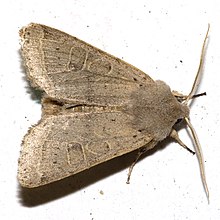|
Common Quaker
 Orthosia cerasi (Fabricius, 1775) The common Quaker (Orthosia cerasi) is a moth of the family Noctuidae first described by Johan Christian Fabricius in 1775. Some authors prefer the synonym Orthosia stabilis (Denis & Schiffermüller, 1775). It is distributed throughout Europe and is also found in Turkey, Israel, Transcaucasia, Russia and eastern Siberia. This is a variable species, the ground colour of the forewings ranging from greyish to orangey brown, sometimes with a broad dark band. The most distinctive features are two large stigmata, each edged by a narrow pale line, with a similarly coloured subterminal line. The hindwings are drab grey or brown. Technical description and variationThe wingspan is 34–40 mm. Forewing reddish grey, more or less dusted with dark: inner and outer lines blackish, indistinct; orbicular and reniform stigmata ringed with ochreous; submarginal line ochreous preceded by a fuscous or rufous shade; claviform mostly unmarked; veins towards termen pale: hindwing grey, the fringe paler. The species varies according to the amount of red present; — ab. pallida Tutt is pale grey, sometimes with an ochreous flush; — obliqua Vill. is darker grey with markings clearer; — suffusa Tutt is an equally well marked blackish-grey form; of these grey forms the second only obliqua Vill. is common; on the other hand when the red tints predominate we get the form rufa Tutt, which is also rare; - in junctus Haw. the upper stigmata, usually separate, are coherent; this accidental connection occurs in all the forms occasionally: — in ab. rufannulata Haw. the stigmata are edged with, and the submarginal line is coloured rufous instead of ochreous.[1] BiologyThis moth flies at night in March and April[1] and is attracted to light and sugar. Larva green thickly dotted with yellowish white; all the lines yellowish white; anal segment with a yellowish-white cross bar; head green with black spots. It feeds on various trees and shrubs including apple, buckthorn, elm, oak, pear, poplar and willow as well as various Prunus species.[2] The species overwinters as a pupa.
References
External linksWikimedia Commons has media related to Orthosia cerasi.
|
||||||||||||||||||||||||||||
